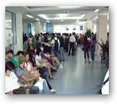If you read the entire story at the link this sounds pretty bad with a lot of frustrations and perhaps some misunderstandings by patients on  what can be cured and treated, the article reflects that. China has an admission problem too but as suggested it was self created with adding insurance to their economy as more could afford care but is this really an answer? As the articles goes on it seems to be leading to a lot of frustration and more people getting care is a good thing for sure, but was the methodology right?
what can be cured and treated, the article reflects that. China has an admission problem too but as suggested it was self created with adding insurance to their economy as more could afford care but is this really an answer? As the articles goes on it seems to be leading to a lot of frustration and more people getting care is a good thing for sure, but was the methodology right?
The violence has increased 70% since 2004 and there’s examples of cancer patients stabbing doctors so the government has some work cut out. 40 to 100 patients a day is not out of the ordinary. Hospitals have had to beef up security. The insurance they do have does not cover a lot of major illnesses such as AIDS and guess what, same thing that happens here, it wipes out family savings. Some doctors and hospitals earn kickbacks and prescribe additional care and treatments that makes extra money and the government is trying to put a lid on that but very hard to enforce I would think. At any rate frustration exists all over it appears with healthcare. BD
HENGYANG, China (AP) — Dr. Chen Yuna had just eaten her lunch and was seated at her desk updating patients' medical records when a masked man entered her office. He pulled out a dagger and stabbed her 28 times in her neck, chest, stomach and elsewhere.
Then he left her to die in a pool of blood.
He knew the hospital well enough to slip out easily: Before he became Chen's killer, the man had been her patient.
Chen's murder in central Hunan province is one of thousands of violent attacks in recent years by patients that have crystallized public discontent with China's health care system, the largest in the world.
Despite an injection of more than $240 billion in government funding into health care over the past three years, the doctor-patient relationship has continued to break down. Doctors are overworked and underpaid, and many push drug sales or charge extra for services such as deliveries to make more money. Patients are faced with high medical expenses, brief consultations and often poor quality care.
The anger built up over years is now exploding into violence, with doctors, nurses and interns around the country stabbed, punched or otherwise assaulted by patients or their relatives over the past year. A few have died. Although official data is unavailable, state media reports say there were more than 17,000 "violent incidents" at health care facilities nationwide in 2010, a 70 percent increase from 2004.
The government cut funding to hospitals. They were allowed to make hefty profits from new drugs and technologies instead, and doctors' bonuses were tied to these revenues. So doctors had an incentive to sell more drugs and tests even if they weren't needed, and expenses skyrocketed.
In general, the government's expansion of health insurance coverage — from 30 percent of the population in 2003 to 96 percent last year — has made it more affordable for people to seek health care. As one result, hospital admissions have surged by two and a half times over the same period. At many top city hospitals, patients line up overnight for consultation tickets or are gouged by scalpers for them.
The government has also announced a code of conduct barring doctors from seeking bribes and accepting kickbacks from medical companies. It is also testing different models of funding at many hospitals to reduce reliance on drug profits, but the situation is not expected to improve soon.
http://www.fox10tv.com/dpp/news/international/Chinas-chaotic-health-care-drives-patient-attacks_43211111



0 comments :
Post a Comment